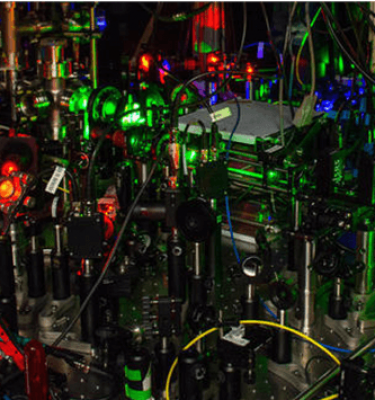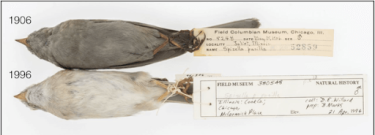Sometimes you need to slow things down to figure out what’s going on. At a molecular level, slowing things down requires some pretty specialized equipment: lasers.
Picture this — you’re a worm. Yep, a worm. And not just any worm, a microscopic worm! How do you know where to go, or which way is up? And more importantly, why do we care? You’ll find out in this lesson.
Picture it: A giant (like, seriously giant) tray full of bacteria. Billions and billions of bacteria just growing and spreading. A germaphobe’s worst nightmare? Nah. These bacteria (like most bacteria) are not only harmless, they’re providing new insights into how evolution works.
Looking at a wolf and a German shepherd, it is easy to think: “Sure, related.” But what about a wolf and a Pekinese? Have you ever seen those dogs? They look like adorable walking footstools! How’d it go from howling at the moon to begging for treats? The answer just might be in the genes. So put on your gene-detective hats and let’s go.
Seen one solid, you’ve seen them all, right? Of course not. In fact, researchers recently developed a whole new type of solid that might be the key to future technologies, from clean energy to more powerful smartphones and computers.
Fins, wings, and…fractions? Find out how simple measurements revealed a striking convergence among animals as varied as whales, birds, and sea butterflies. (Wondering what a sea butterfly is? We were, too. Lucky for you, the answer is in the Bite.)
The vastness of space can boggle the mind, but when it comes down to it, the same forces that determine what happens when you drop an apple in the lunch line also determine how galaxies form and move. Of course, there isn’t much dark matter or gamma rays in the school cafeteria, but still, it’s mostly the same. You’ll see.
What if you could cure cancer with gold? Yes, gold. But not just any gold… vibrating nanoparticles of gold. Sounds totally bizarre, but it’s a real thing. This lesson has hands-on lab that along with the Science Bite and our usual mix of engaging BiteScis questions will really BLING home the concept of resonance. (Get it? Like “bring,” only it’s “bling” because… gold.)
Researchers, with a little help from fireflies, are developing new tools for studying cancer by applying their knowledge of electronegativity and bonding.
What do a bat, a pig, a mouse, and an opossum have in common? In this lesson plan students will explore both the structural and genetic homology of tetrapods!
Researchers have been tracking E.coli through 60,000 generations to answer a fundamental question: How does natural selection work in a constant, stable environment?
What do aching knees, a sore back, diabetes, and poor eyesight have in common, besides being, well, common? You’ll find out in this lesson, but here’s a hint: it has something to do with evolution.
Quantum physics is behind advances in digital cameras and cell phones, so it must also be able to explain the basics, right? Wrong. It turns out that classical physics doesn’t always work in the quantum world.
What if we told you this lesson was about planets outside our solar system passing gas? But don’t worry, it’s *physics* gas! Students will learn a lot, we promise.
Think that evolution always results in disadvantageous traits becoming less common in a population? Think again.
What do we do about the microscopic particle of all-things-bad coronavirus? Well, to quote Matt Damon in The Martian: We’re going to have to science the *bleep* out of this. And it’s never been more important to remember how science works.
Using DNA analysis, researchers were able to effectively trace the evolution of HIV backwards in time to find the common ancestor of HIV samples circulating among humans today. Why is that important? Because the lessons they learned about how the virus changes and spreads may help us to stay one step ahead of HIV in the future.
There are more than 100,000 people in the United States in need of a healthy organ, whether liver, kidney, heart, or something else. Wouldn’t it be great if instead of having to wait for a donor, we could just print healthy organs, on-demand, for anyone who needs them? It sounds bonkers, but thanks to some cool chemistry, it just might one day be a reality.
The Milky Way is our “home” galaxy but how much do we really know about it? Thanks to a phenomenon known as “dust extinctions,” space is pretty hard to observe even with our best telescopes. With a little understanding of the basic wave properties of light, however, scientists are beginning to get a clearer picture of what lies at the center of our galaxy.
What separates the gold medal sprinters from the casual weekend jogger…besides the intense training, of course? Thanks to a careful analysis of human runners and good old-fashioned physics, we now have a pretty good idea.
Researchers are making waves in an unlikely place: the human body. The reason? To detect and diagnose diseases.
The rules of sexual inheritance are simple, right? Half the genes from parent one, the other half from parent two and bada-bing! New organism. What if we told you there is an exception to that rule, and then what if we told you there is an exception to the exception to that rule? Intrigued? So were a bunch of doctors and geneticists in Cincinnati. Join them as they unravel a mystery rooted in the mitochondria.
What happens when a planet forms near a black hole? That’s what a bunch of researchers wanted to know. And it turns out that it’s not too unlike a scene in the old movie Spaceballs where the atmosphere gets sucked up by a vacuum cleaner. Cool, right?
When I think space stuff, I think solid, steady masses moving in organized orbits and rotations. But it turns out, they wobble! Isn’t that kind of cute to think of a wobbling planet? Just me? Well, anyway, it turns out that the wobbles of stars and planets can help us know more about the universe. How? Check out the lesson to find out.
Space is big. (duh). So big that getting anywhere close to even our solar system’s nearest neighbors seems impossible. But what if we told you that you that researchers have a plan to make light-speed space exploration a reality? One-way trip to Proxima Centauri, anyone?
Remember when our solar system had nine planets? (If you don’t, please don’t tell me because it reminds me of how old I am). Well, not satisfied with eight planets, some astronomers have been using some nifty physics to bring back planet nine. Is there evidence strong enough to rewrite textbooks again? You decide.
As traditional carbon-based sources of energy are dwindling, it’s easy to cheer for solar and wind power to seize the moment and drag us out of the climate crisis bed we have made for ourselves. However, there is a pretty big problem with green energy sources: How do we store them for a cloudy or windless day? Enter the battery–but not just any battery. A super cool battery. Check out this lesson to learn more.
Natural history museum collections house some truly odd things, from random bits of fossil and bone to whole organisms preserved forever in jars of icky liquid. In this lesson, a team of scientists examine 100+-year-old birds and come to find out that these creatures from the past have a lot to say about our future.
How do you design a robot that can swim efficiently under water? Scientists are studying the physics behind dolphin movement for the answer! (And if you’re wondering why scientists are designing robots that can swim efficiently under water… this lesson covers that, too.)
Tanning mice. Yep. You read that right. Mice with tans are at the center of this story of how researchers are looking into drugs that can trick our cells into tanning without the sun.
Newborn babies have very immature immune systems, but they aren’t completely defenseless against disease. Some antibodies pass from the parent’s blood to the fetus’ blood during development. But which antibodies, and why not all antibodies? A curious BiteScientist set out to find the answers, and students can follow her journey of discovery with a little knowledge of membrane transport.
Modern computer modeling unveils something surprising about a classic example of evolutionary convergence and divergence: the Anolis lizards of the Caribbean.
Newton’s laws don’t only apply here on Earth. The most basic of physics principles are helping astronomers to understand strange phenomena lightyears away.
When you think Galápagos, you probably think about biology (and with good reason), but as BiteScis co-founder Shannon Morey explains in this lesson, physics provides the key to understanding how climate change affects the Galápagos’s coral reef ecosystem.
Have you ever seen a headline like, “Planet a zillion* kilometers away has water vapor in its atmosphere!” and wondered how do they know that? Turns out the answer is pretty simple: Light! Turns out that light being both a particle and a wave comes in handy if planets a zillion kilometers away are of interest to you—and why wouldn’t they be? That stuff’s bananas cool.




































